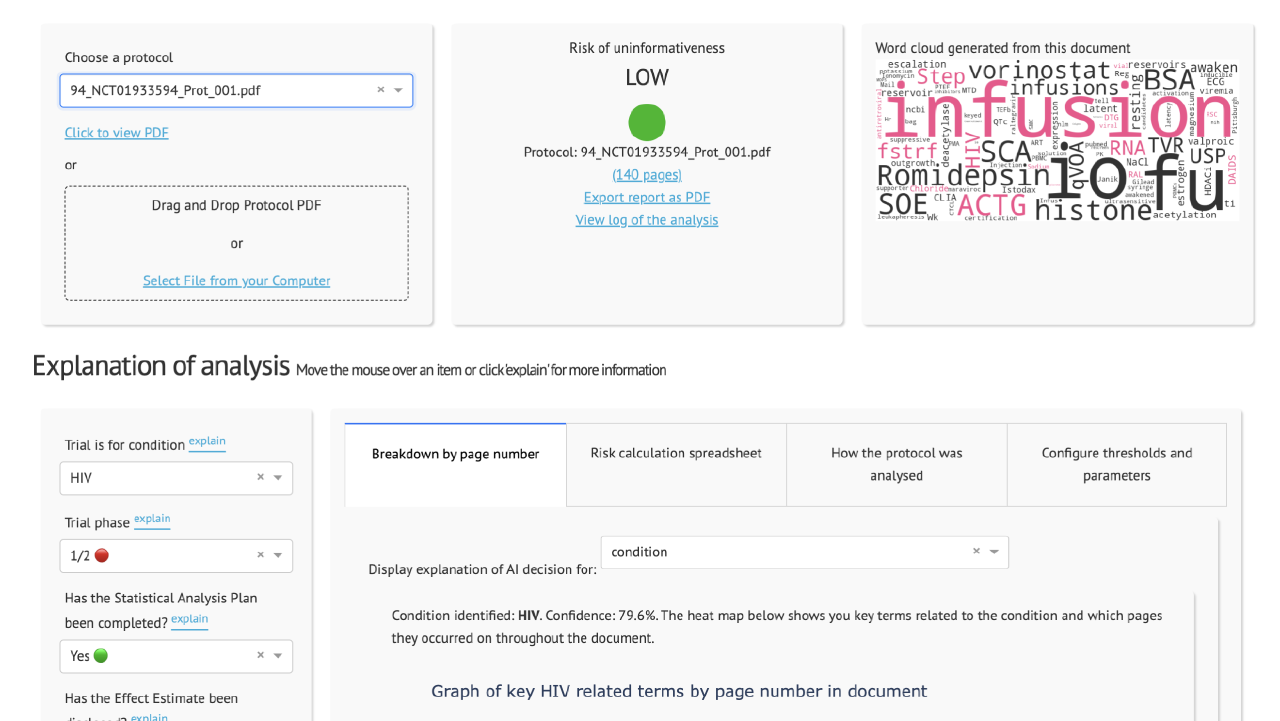Coming out soon
We have developed a machine learning and rule based tool called the Clinical Trial Risk Tool using natural language processing. The Clinical Trial Risk Tool allows a user to upload a trial protocol and which categorises the protocol as high, medium, or low risk of ending uninformatively.
When a pharmaceutical company develops a drug, it needs to pass through several phases of clinical trials before it can be approved by regulators.
Before the trial is run, the drug developer writes a document called a protocol. This contains key information about how long the trial will run for, what is the risk to participants, what kind of treatment is being investigated, etc.
The tool is open-source under MIT licence and it does not save any of your data.

Currently, professionals at a funding organisation read the protocols and perform a subjective assessment of the trial’s cost, complexity, and risk of ending uninformatively.
One of the most common causes of a trial ending uninformatively is underpowering. There are several indicators of high risk of uninformativeness which can be identified in a protocol, such as a lack of and or an inadequate statistical analysis plan, use of non-standard endpoints, or the use of cluster randomisation. Low-risk trials are often run by well-known institutions with external funding and an international or intercontinental array of sites. These indicators can be referred to as features or parameters.


If you would like to cite the tool alone, you can cite:
Wood TA and McNair D. Clinical Trial Risk Tool: software application using natural language processing to identify the risk of trial uninformativeness. Gates Open Res 2023, 7:56 doi: 10.12688/gatesopenres.14416.1.
A BibTeX entry for LaTeX users is
@article{Wood_2023,
doi = {10.12688/gatesopenres.14416.1},
url = {https://doi.org/10.12688%2Fgatesopenres.14416.1},
year = 2023,
month = {apr},
publisher = {F1000 Research Ltd},
volume = {7},
pages = {56},
author = {Thomas A Wood and Douglas McNair},
title = {Clinical Trial Risk Tool: software application using natural language processing to identify the risk of trial uninformativeness},
journal = {Gates Open Research}
}Blog

This post originally appeared on Fast Data Science’s blog on LinkedIn. Clinical trials are essential for medical advancement but are not without risk. Delays, budget overruns, and compliance issues can derail the most carefully planned studies. Proactive risk management is the key to ensuring patient safety, maintaining regulatory compliance, and achieving successful trial outcomes. In this article we’ll explore the key risks in clinical trials, how AI-powered tools like the Clinical Trial Risk Tool can help mitigate these risks, and practical strategies for ongoing risk monitoring.

This post originally appeared on Fast Data Science’s blog on LinkedIn. Discover how the Clinical Trial Risk Tool helps optimise clinical trial workflows with accurate risk and cost analysis. Save time and reduce costs. Why Workflow Efficiency Matters in Clinical Trials Running a clinical trial is a complex and expensive process. Delays, unexpected costs, and inefficiencies can waste time and money, affecting trial outcomes and patient care. As trials become more complicated, workflow management is more important than ever.

This post originally appeared on Fast Data Science’s blog on LinkedIn. In today’s ever-evolving healthcare landscape, technology is crucial to improving patient care, streamlining processes, and enhancing outcomes. Natural Language Processing (NLP) is one such technology that is revolutionising the way healthcare organisations operate. For instance, NLP has been used to analyse patient feedback and identify trends in satisfaction levels, leading to targeted improvements in service quality. In this article, we will explore the role of NLP in healthcare, its benefits, and potential applications.